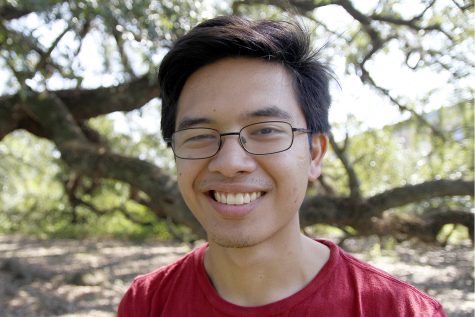
Dr. Sanichiro Yoshida discussed how people can use physics in their daily lives for the "Science on Tap" lecture series. Zachary Araki/The Lion's Roar
The fifth year of “Science on Tap” continued this semester with a talk focusing on how people can employ physics in their everyday activities.
Professor of Physics Dr. Sanichiro Yoshida presented “Physics in our Daily Life – How Beautiful It Is” in the Tope La catering building on Feb. 6 at 7 p.m.
“In our daily lives, many people do not know the underlying physics for any activity,” said Yoshida. “For example, people try to lose weight by doing exercise. Maybe they know if they run or jog for half an hour how many calories they can consume, but they may not know what makes whatever number they consume. It’s very simple physics. You can calculate how much force you exert with each step and how many miles or meters they go can calculate into calories. In that way, they can deepen their understanding.”
In his own daily life, Yoshida applies physics in tennis and judo.
“When I play tennis, I think about momentum transfer,” said Yoshida. “When you hit the ball, the momentum is transferred from your body through the racket to the ball. So, if you have longer contact time with the ball, with the same force, the change in momentum is force times contact time. So, by having longer contact, you can have more momentum transferred to the ball. Therefore, your ball is faster and more powerful. When I practice judo, I always think about how to turn the body. This is very good for moment of inertia when you’re talking about the rotation motion.”
Professor of Biological Sciences Dr. Brian Crother, who organizes “Science on Tap,” wanted to try “something different” when choosing a speaker for “Science on Tap.”
“We try to get good scientists to talk about their field, people I know that can break down their subject and talk to a lay audience that can understand it,” said Crother.
Yoshida discussed a common misconception of physics.
“They think physics is simply calculation, and they’re looking for a formula to use,” said Yoshida. “That’s not physics. Physics is more like continuous steps of logical thinking. So, one thing is calculators. They use calculators. Calculators do not show you any logic. You just put numbers into the calculator. It gives you another number.”
Yoshida compared people’s approach to physics when using calculators to his own experience without them.
“When I was in middle school, there was no calculator, so we had to go through step by step by hand,” said Yoshida. “If you used a hand to calculate, you have to calculate each step. You cannot do open parentheses, a plus b, close parentheses, times five times whatever by keypad operations. You have to calculate something plus something, get the answer, then multiply something, get the answer. Each individual step is relevant to some underlying physical event. We could visualize those steps, but now, they don’t have a chance to do that.”
Crother shared his thoughts on the presentation.
“I loved it,” said Crother. “It’s really hard to break down physics for a lay audience. Even though there were a few equations up there, they were all very, very simple equations, and he related them to really nice, real-world problems. And so, everybody could just look at the pictures and understand what the equations meant.”


